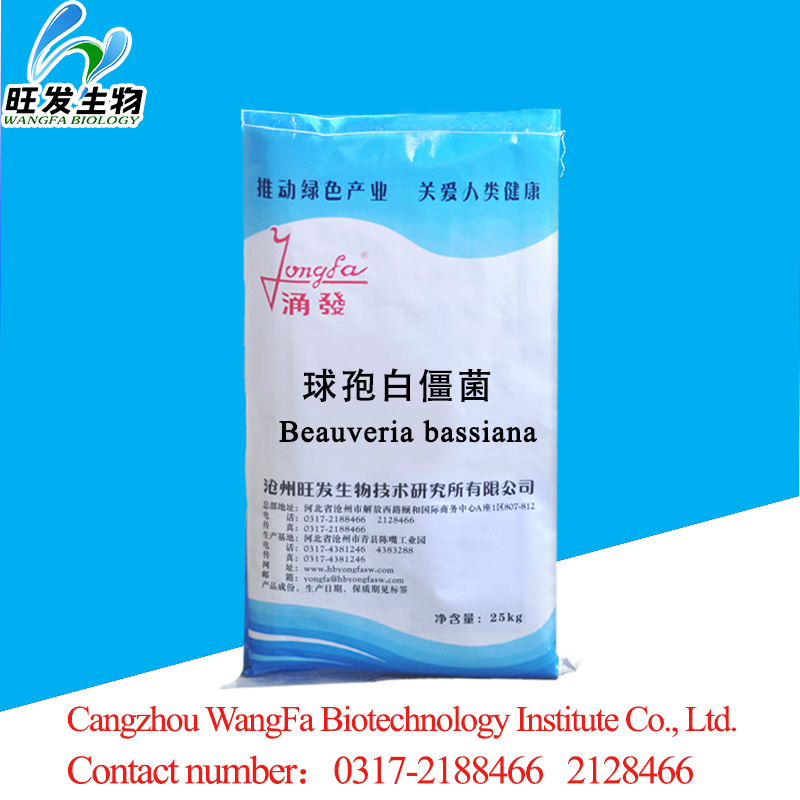
Beauveria bassiana
[main ingredients] of Beauveria bassiana, fermentation products.
[properties] powder
[] the biological characteristics of Beauveria bassiana in belong to deuteromycotina, hyphomycetes, moniliales Moniliaceae, Beauveria bassiana. Beauveria bassiana is one of the entomopathogenic fungi pest control is widely used at home and abroad, is considered to be a kind of entomopathogenic fungi most potential. Beauveria bassiana belongs to the Neurospora families, can parasitic on 60 species of insect body.
[Mechanism] for fungal insecticide formulations of Beauveria bassiana. Beauveria bassiana conidia in the host epidermis or pores, digestive tract, in appropriate conditions to germination, germ tube was born. At the same time, lipase, protease and chitinase dissolve the insect's epidermis, invade the insect body from the bud tube, grow and propagate in the worm body, consume the nutrient in the host, form a large number of mycelium and spores, and fill the body of the insect body. At the same time to produce a variety of toxins, beauvericin, Beauveria and oospores etc. Prime white muscardine containing N- methyl amino acid ring elbow. Mainly through contact with infected insect cuticle, followed by digestive and respiratory infections. The infection way is different because of the insects, insect, environment condition etc.. In disseminated leafhopper through skin infection. The germinated conidia is sprouting tube in the thin internode membrane of the body wall of the insect body. The tip of the bud tube secretes a chitinase that dissolves chitin into a small hole, and the germinating tube enters the insect body. Now about 24 hours of infection. The germination of the germ tube, through the action of enzyme, continuously dissolves the chitin of the body wall and extends forward until the mycelium generated by the epithelial cells of the body wall enters the body wall and invades the hemolymph tissue. At first the mycelium grows and grows through the cell membrane, and then passes through the cell membrane into the cell, so the protoplasm and nucleus are inactivated and the nutrients are exhausted. A large number of disappeared. The destruction of a large number of subcutaneous cell layers is due to the infection of the mycelium in the body cavity. At this time, the mycelium is surrounded by the blood cells in the insect and in the body, the blood cells appear vacuoles, and the coloring force is reduced. At the same time many hypha produced blastospores. Blastospores after germination, produce new hyphae, which repeated blood cell proliferation, break through the barrier into the body. In the body cavity, the spores and conidia are propagated and spread to all the tissues of the insect body, such as the digestive tract, the martensitic tube, the fat body, and so on, about 48~72 hours of infection. After 96 hours of infection, most of the tissues and organs of the insect were destroyed. The mycelium penetrated through the body surface, formed the mycelium, and began to form the conidium and conidium. After 118~120 hours of infection, a large amount of mycelia, spore stem and conidia released from the body surface of the insect were released. At this time, other tissues were destroyed and the nutrients were depleted at the part of the body wall.
[object] underground pest grub, wireworm, tiger, mole cricket Coleoptera, Lepidoptera, orthoptera. It can also be used to prevent and control houseflies, insects, aphids, thrips, potato leaves, grasshoppers, grasshoppers, grasshoppers, grasshoppers, crickets, cotton bolls, cotton bugs, Spodoptera Spodoptera, beet moth, pod borer, vegetable borer, melon borer, corn borer, corn borer, beetle, corn borer, corn borer, tea leafhopper, peach. Carposina niponensis etc..
[main effect]
1, effective pest control by biological methods. Beauveria bassiana can parasitism on a variety of pests, enter the body of pests, reproduce toxins in the pests, and continue to spread in the pest population to kill the pests. Can effectively reduce the damage of grubs, mole crickets, wireworms, chive maggot.
2, green environmental protection, safe and reliable. This product is a fungal biological insecticide, harmless to human and livestock, and no environmental pollution, no residue, no resistance to pests.
3, promote crop growth, increase yield. This product is made by the method of liquid solid fermentation. Many kinds of nutrients, such as amino acids, polypeptide enzymes, trace elements and so on, are produced in the process of fermentation, and many kinds of growth promoting substances such as gibberellin, indoletacetic acid and cytokinin are produced, which make the crop root fast, greatly strengthen the ability of absorbing water and fertilizer, and improve the crop effectively. Yield and quality.
[usage]
1, bottom application: 1000-2000 grams per mu, mixed with organic manure or fine soil, evenly spread to the ground, ploughing soil, then water once, to maintain the relative humidity of soil over 80% in three days.
2, when the amount of acres: 500-1000 grams, in seedling transplanting, the inoculum on cultivation points lower, and then transplanted to.
3, Chong Shi Mu: dosage of 500-1000 grams, sugar, 3 kg, 50 kg of water, activated and cultured for 3-5 days at a temperature of 20-30 DEG C, mix with the water spraying. Suitable for transplanting after pouring root water and crop growth period of topdressing.
[note]
1, the preparation for the higher soil moisture content or irrigated areas, the soil is too dry can affect the control effect.
2, avoid high temperature and direct sunlight, sparaying should be promptly covered soil. The goods can not be exposed to sunlight.
3, prohibited the use of direct mixing with fungicides.
4, this product is poisonous to silkworm mulberry sericulture area and in the vicinity of the disabled.
[use] the scope of agricultural planting, microbial fertilizer.
[storage] stored in a cool, dry place, anti exposure.
The shelf life of 18 months [].

